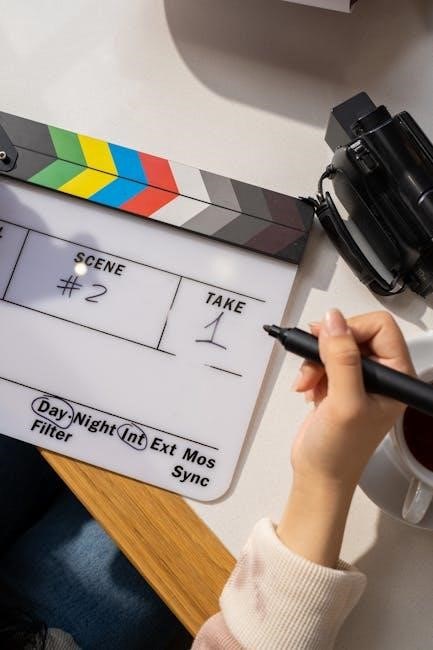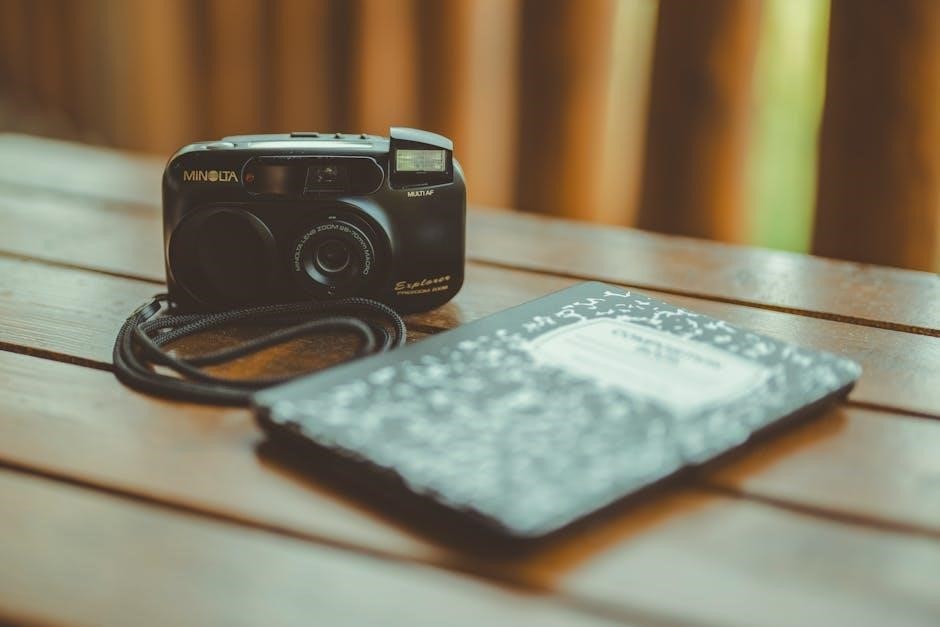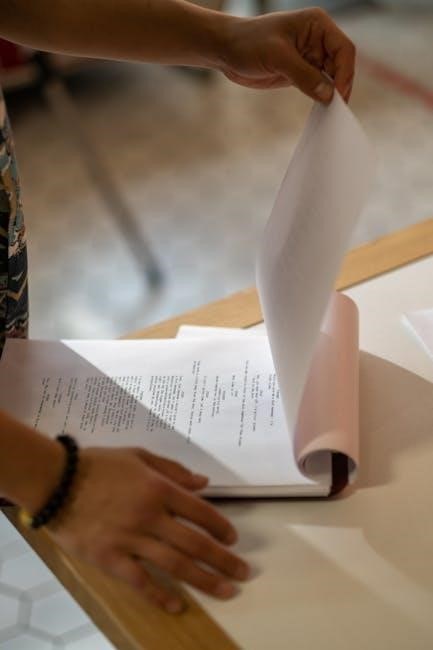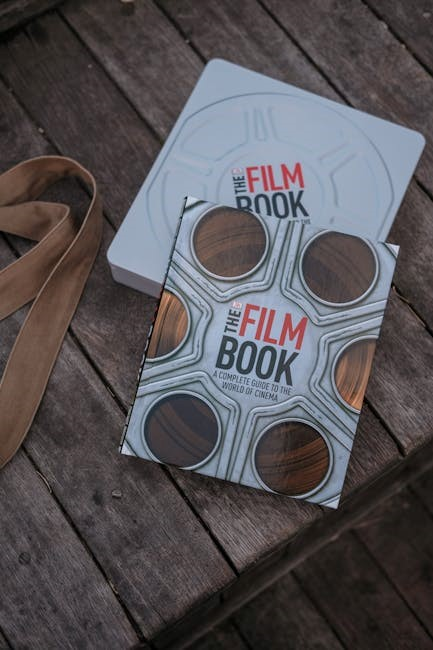T. Corrigan’s guide bridges academic and casual film analysis, offering practical advice for students and enthusiasts. It covers foundational stages of writing, from preparing to watch films to integrating technical analysis, fostering deeper engagement with cinema.
1.1 Overview of the Book’s Purpose and Structure
T. Corrigan’s guide is designed to enhance film writing skills for both students and casual movie lovers. It provides a structured approach, covering key stages from preparation to analysis. The book emphasizes practical advice, encouraging readers to think critically about cinema. Divided into clear sections, it progresses from foundational concepts to advanced techniques, ensuring a comprehensive understanding. Corrigan’s approach fosters engagement with film as an art form, making it an essential resource for anyone aiming to deepen their appreciation and analytical skills in writing about film.
1.2 Timothy Corrigan’s Approach to Film Writing
Timothy Corrigan’s approach emphasizes clarity and accessibility, catering to both students and casual film enthusiasts. His teaching philosophy encourages writers to bridge observation and analysis, fostering a deeper connection with cinema. Corrigan’s method focuses on practical advice, guiding readers to describe what they see and think, and to use these observations as the foundation for critical analysis. His approach is rooted in the belief that film writing should enhance understanding and engagement, making it a valuable tool for anyone looking to refine their analytical and writing skills in the realm of film studies;

The Basics of Film Analysis
Film analysis involves examining key elements like plot, characters, cinematography, and sound, while understanding terminology and the importance of scene analysis to interpret cinematic narratives effectively.
2.1 Key Elements of Film to Analyze
Film analysis involves examining key elements such as plot, characters, mise-en-scène, cinematography, editing, and sound. Each component contributes to the overall narrative and thematic depth. Plot structure and character development reveal storytelling techniques, while mise-en-scène (settings, costumes, props) provides visual context. Cinematography, including lighting and camera angles, influences mood and perspective. Editing shapes pacing and tone, and sound design enhances emotional impact. By analyzing these elements, viewers gain insight into themes, directorial intent, and cultural context, enabling a deeper understanding of the film’s artistic and narrative significance.
2.2 Understanding Film Terminology
Mastering film terminology is essential for effective analysis. Terms like “mise-en-scène” (settings, costumes, props), “cinematography” (lighting, camera angles), and “editing” (cuts, transitions) describe visual and technical aspects. Understanding “sound design” (dialogue, music, effects) and “narrative structure” (plot, pacing) enhances critical discussions. Corrigan emphasizes the importance of using precise language to describe what you see and think, helping writers focus their observations. Familiarity with these concepts enables deeper analysis and insightful discussions about film artistry and storytelling, aligning with Corrigan’s approach to thoughtful and engaging film writing.

2.3 The Importance of Scene Analysis
Scene analysis is vital for understanding a film’s themes and directorial intent by examining specific moments. Through close examination of mise-en-scène, cinematography, and sound in individual scenes, writers uncover deeper meanings. This approach helps organize essays, focusing on scenes that highlight character development or thematic elements. Corrigan emphasizes that scene analysis transforms summaries into rich explorations, providing insights into the film’s artistic and narrative strategies.

Types of Film Writing
Corrigan categorizes film writing into critical essays, theoretical essays, and movie reviews, each reflecting distinct analytical approaches and purposes. Understanding these types aids in developing a structured writing approach.
3.1 The Critical Essay
The critical essay is a rigorous analytical approach to film writing, focusing on interpreting and evaluating cinematic works. Corrigan emphasizes its purpose: to explore themes, directorial intent, and cultural contexts. Unlike reviews, critical essays delve deeper, offering insightful arguments supported by close analysis of scenes, cinematography, and editing. They require a clear thesis and evidence-based reasoning. This type of writing encourages readers to engage with films on a deeper level, examining how elements like genre, narrative, and visual style contribute to meaning. It is both interpretive and evaluative, aiming to illuminate the film’s artistic and intellectual significance.
3.2 The Theoretical Essay

The theoretical essay applies specific film theories to analyze and interpret cinematic works, offering a framework for understanding their underlying structures and meanings. Corrigan highlights its focus on conceptual approaches, such as auteur theory, genre studies, or feminist criticism, to explore how films reflect or challenge cultural, social, or philosophical ideas. This type of essay requires a strong foundation in film theory and the ability to apply it critically. It encourages writers to connect films to broader intellectual traditions, demonstrating how theory illuminates the text and deepens interpretation. The goal is to engage with the film as a cultural artifact and intellectual construct.
3.3 The Movie Review
The movie review is a concise, accessible analysis aimed at a general audience, evaluating a film’s artistic and entertainment value. Corrigan emphasizes its focus on providing clear opinions supported by specific examples, such as performances, direction, or cinematography. Unlike academic essays, reviews are less formal, prioritizing readability and brevity. They often include recommendations, addressing whether the film is worth viewing. Effective reviews balance personal perspective with objective analysis, offering insights that help readers form their own opinions. The goal is to engage, inform, and persuade, making the review a valuable tool for both filmmakers and audiences.

The Writing Process
The writing process involves systematic steps like preparation, note-taking, outlining, and research, guiding film writers to transform observations into coherent, analytical texts effectively.
4.1 Preparing to Watch a Film
Preparing to watch a film involves setting clear expectations, researching its background, and gathering tools for analysis. Start by understanding the film’s context, such as its director, genre, and historical background. Familiarize yourself with key themes or debates surrounding the film to guide your analysis. Bring a notebook or digital recorder to capture initial impressions and questions. Having a copy of the script or shot-by-shot breakdown can also aid in detailed observation. Lastly, clarify your purpose: are you analyzing themes, techniques, or cultural impact? This preparation ensures a focused and productive viewing experience.

4.2 Taking Notes During a Screening
Taking notes during a film screening is crucial for capturing immediate reactions and observations. Focus on key elements like visuals, sound, and dialogue that stand out. Record specific scenes, shots, or lines that resonate with the film’s themes or your analysis. Note character interactions, camera movements, and pacing. Jot down questions or interpretations as they arise. Be concise but thorough, using symbols or shorthand for efficiency. Avoid overwriting; prioritize clarity and relevance. These notes will serve as the foundation for your analysis, helping you recall details and develop insights post-viewing.
4.3 Developing an Outline
Developing a clear outline is essential for organizing your thoughts and structuring your analysis. Start by identifying the main thesis or argument, then break it down into key points. Organize these points into sections, such as introduction, plot analysis, thematic exploration, and conclusion. Ensure each section flows logically to the next. Use your notes from the screening to support your ideas. A strong outline helps maintain focus, prevents tangents, and ensures your writing is cohesive. It also saves time during the drafting phase by providing a roadmap for your essay.
4.4 Conducting Research
Conducting research is crucial for enriching your film analysis and supporting your arguments. Start by gathering scholarly articles, film reviews, and theoretical texts relevant to your topic. Look for insights from critics and historians to deepen your understanding. Research the director’s background, interviews, and stated intentions to contextualize the film. Additionally, explore cultural and historical contexts that influenced the film’s production and reception. Integrate this information seamlessly into your writing to strengthen your analysis. Remember to balance research with your own observations to maintain a unique voice and perspective in your essay.
4.5 Integrating Technical Analysis into Your Writing
Integrating technical analysis into your writing enhances your film critique by connecting visual and auditory elements to thematic ideas. Discuss cinematography, sound design, and editing to explain how they shape the narrative. For example, analyze how camera angles or lighting reflect a character’s emotional state. Use specific terminology to describe techniques like mise-en-scène or diegetic sound. Link these observations to the director’s intent or the film’s broader themes. This approach ensures your analysis is both detailed and insightful, offering readers a deeper understanding of the film’s structure and artistic choices.

Advanced Techniques in Film Writing
Advanced techniques involve applying film theory, historical context, and genre analysis to deepen your critique. Explore directorial intent, thematic complexity, and cinematic devices for a sophisticated analysis.
5.1 Using Film Theory in Your Analysis
Film theory provides a framework for analyzing movies beyond surface-level observations. Corrigan emphasizes theories like auteur theory, genre studies, and feminist criticism to uncover deeper meanings. By applying these frameworks, writers can explore themes, styles, and cultural contexts. For instance, analyzing a director’s consistent themes (auteur theory) or deconstructing gender roles (feminist criticism) adds depth to your critique. Theory helps bridge the gap between observation and interpretation, enabling writers to connect films to broader cinematic and societal discussions. This approach transforms analysis into a richer, more insightful exploration of cinema.
5.2 Incorporating Historical Context
Historical context enriches film analysis by connecting movies to the social, political, and cultural landscapes of their time. Corrigan highlights the importance of understanding the era in which a film was made and received. This context reveals how films reflect or challenge societal norms, political ideologies, or cultural shifts. For example, films from the 1950s may mirror Cold War anxieties, while 1960s cinema might embody countercultural movements. By situating films within their historical backdrop, writers can uncover layers of meaning and better interpret the director’s intent and the audience’s response, adding depth to their analysis and critique.
5.3 Analyzing Film Genres
Film genres provide a framework for understanding movies by categorizing them based on themes, styles, and audience expectations. Corrigan emphasizes the importance of analyzing genres to uncover how films conform to or subvert conventions. For instance, horror films often rely on suspense and fear, while comedies focus on humor. Recognizing genre patterns helps writers identify a film’s unique contributions and limitations. By comparing a film to others in its genre, analysts can highlight its originality or adherence to tradition, enriching their critique with insights into how genres shape storytelling and viewer experiences.
5.4 Exploring the Role of the Director
The director plays a pivotal role in shaping a film’s artistic and narrative vision. Corrigan highlights the importance of examining a director’s style, themes, and influences to deepen analysis. By studying a director’s body of work, writers can identify recurring motifs and techniques that define their approach. Understanding the director’s intent and creative decisions provides insight into the film’s meaning and significance. This approach encourages writers to move beyond surface-level analysis, offering a more nuanced exploration of how a director’s unique perspective contributes to the film’s overall impact and resonance with audiences.

Common Challenges in Film Writing
Film writers often struggle with avoiding plot summaries, balancing objective and subjective analysis, and addressing audience expectations. These challenges require careful planning and critical thinking to overcome effectively.
6.1 Avoiding Plot Summary
One of the most common challenges in film writing is avoiding the temptation to summarize the plot. Writers often fall into this trap, believing that recounting events will convey their understanding. However, Corrigan emphasizes that meaningful analysis requires moving beyond mere storytelling. Instead, focus on interpreting themes, characters, and cinematic techniques. This approach shifts the emphasis from “what happens” to “why it matters.” By doing so, writers can provide deeper insights and engage readers more effectively. Corrigan suggests using close readings of specific scenes or sequences to ground analysis and avoid unnecessary plot details.
6.2 Balancing Objective and Subjective Analysis
Film writing often requires balancing objective and subjective analysis to maintain credibility. Objective analysis involves examining factual elements like cinematography, editing, and sound, while subjective analysis explores personal interpretations of themes or characters. Corrigan advises writers to ground subjective claims in textual evidence, ensuring opinions are supported by specific examples. This balance prevents analysis from becoming overly biased or disconnected from the film itself. By integrating both approaches, writers can provide a nuanced and comprehensive exploration of cinema, appealing to both critical thinkers and film enthusiasts. This balance is essential for impactful and engaging film criticism.
6.3 Addressing Audience and Purpose
Understanding your audience and purpose is crucial in film writing. Corrigan emphasizes tailoring your analysis to engage specific readers, whether scholars, students, or general film enthusiasts. Academic writing requires a formal tone and technical language, while informal reviews should be accessible and engaging. Clarity and purpose ensure your writing resonates with its intended audience. By aligning your analysis with the reader’s expectations, you create a focused and impactful discussion. This approach helps bridge the gap between critical insight and audience engagement, making your film writing both informative and compelling.

Tips for Improving Your Film Writing
- Revise and refine your work for clarity and impact.
- Seek feedback from peers or mentors to enhance quality.
- Practice writing regularly to develop your critical voice.
- Engage with film communities to expand your perspectives.
- Apply theoretical insights to deepen your analysis.
7.1 Revising and Editing Your Work
Revising and editing are crucial steps in refining your film writing. Start by reviewing your draft to ensure clarity, coherence, and conciseness. Take breaks between writing and revising to approach your work with fresh eyes. Check for grammatical errors, awkward phrasing, and redundant ideas. Use style guides to maintain consistency in formatting and citations. Consider feedback from peers or mentors to strengthen your analysis. Finally, ensure your arguments align with your thesis and effectively convey your insights about the film. Revision is not just about correcting mistakes—it’s about enhancing the overall quality and impact of your writing.
7.2 Seeking Feedback
Seeking feedback is essential for improving your film writing. Share your work with trusted peers, mentors, or writing groups to gain diverse perspectives. Encourage specific, constructive criticism rather than vague praise. Ask questions like, “Is my analysis clear?” or “Do I effectively support my arguments?” Use this feedback to identify strengths and areas for improvement. Be open-minded and willing to revise based on insightful suggestions. Feedback provides valuable external insights, helping you refine your ideas and enhance the clarity and persuasiveness of your writing. It’s a key step in producing polished, impactful film analysis.
7.3 Engaging with Film Communities
Engaging with film communities enhances your writing by exposing you to diverse perspectives. Participate in film clubs, attend screenings, and join online forums to connect with fellow cinephiles. These interactions foster a deeper understanding of films and refine your analytical skills. Engaging in discussions allows you to test your ideas, gain insights, and discover new approaches. Active involvement in film communities also keeps you informed about trends and critical debates. Collaborating with others passionate about cinema enriches your writing and helps you grow as a film writer, ensuring your work resonates with broader audiences.
Timothy Corrigan’s guide equips writers with tools to master film analysis, emphasizing critical thinking, technical skill, and creative expression. This structured approach ensures a comprehensive understanding of cinema.
8.1 The Importance of Film Analysis in Understanding Cinema
Film analysis is essential for deeply understanding cinema, as it reveals the artistic and technical choices that shape narratives. By examining elements like cinematography, direction, and sound, analysts uncover how themes and emotions are conveyed. Corrigan emphasizes that such critical engagement enhances appreciation and fosters a deeper connection with films. It also encourages viewers to consider cinema’s cultural and social contexts, making it a vital tool for both scholars and enthusiasts. Through analysis, cinema transforms from mere entertainment into a rich medium for exploration and interpretation.
8.2 Final Thoughts on Mastering Film Writing
Mastering film writing requires a balance of technical skill, critical insight, and creative expression. Corrigan underscores the importance of integrating personal perspective with analytical rigor. Film writing is not just about describing films but interpreting their cultural, social, and artistic significance. Continuous practice, along with a willingness to revise and adapt, is key to refining one’s craft. By embracing diverse approaches and staying open to new ideas, writers can deepen their understanding of cinema and communicate their ideas more effectively. Ultimately, film writing is a journey of exploration and growth.